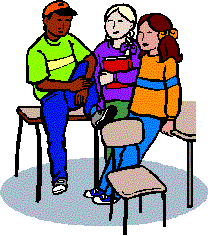|
|
|
|
|
|
 Readers may learn best when they are in social
situations in which they are actively engaged with other learners who
are near their same level of understanding. Cooperative learning involves
readers reading together with a partner or in small groups. As they read
aloud and listen to others, the teacher can guide them to use any of the
various strategies for effective reading comprehension.
Readers may learn best when they are in social
situations in which they are actively engaged with other learners who
are near their same level of understanding. Cooperative learning involves
readers reading together with a partner or in small groups. As they read
aloud and listen to others, the teacher can guide them to use any of the
various strategies for effective reading comprehension.
At first, the teacher may model reading through her demonstrated use of a strategy. Then the student readers carry out the demonstrated activities with a partner or in small reading groups.
Readers take turns reading and listening, asking questions, answering questions, summarizing, recognizing words, predicting, and clarifying. The readers are encouraged to tutor each other on strategies.
Group cooperative instruction has been found to promote intellectual discussion, increased student control over their learning, increased social interaction with peers, and savings in teacher time.
For example, in 1998 Janette K. Klingner, Sharon Vaughn, and Jeanne S. Schumm investigated the effectiveness of a cooperative learning approach designed to encourage culturally and linguistically diverse general education fourth-grade students to use strategic reading by employing various summarization and clarification procedures during reading. Students in the cooperative learning classes made greater gains in reading comprehension and equal gains in content knowledge than controls in measures that included a standardized reading test, a social studies unit test, and audiotapes of group work.
In ten studies on cooperative learning of comprehension strategies reviewed by the NRP, students successfully learned the reading strategies. Cooperative learning can also be effective for integrating students with academic and physical disabilities into regular classrooms. The social interaction increases motivation for learning and time spent by the learners on tasks.